It’s a common saying that a truly great song can stand strong even when stripped down to the simplest chords on an acoustic guitar. While that’s often true, there’s no denying the magic that complex and unique chord voicings can bring to a piece of music. Many unforgettable songs utilize chord progressions where intricate or unusual harmonies are absolutely integral to their character. For acoustic guitar players looking to enrich their sound, understanding and utilizing a broader palette of chords is essential.
Sometimes, a song might blend both approaches seamlessly – using familiar major and minor chords as a foundation, then layering in more sophisticated or extended voicings on top. This technique is especially effective when using two acoustic guitars, panning them left and right to create a rich, stereo soundscape. Whether you prefer the simplicity of fundamental chords or the complexity of advanced voicings, expanding your chord vocabulary is key to unlocking new creative avenues on your acoustic guitar.
The following selection of chords is designed to provide you with inspiration and practical tools. We’ve included a diverse range of chords, representing every key with both a major and minor example. In addition to these, you’ll find six ‘bonus’ chords, chosen simply because they offer particularly pleasing and inspiring sounds. Consider this collection as your starting point. The world of guitar chords is virtually limitless, and there are always more fascinating and beautiful sounds to discover.
While some of the examples shown here can be adapted to different keys and positions across the fretboard, the focus here is on the unique resonance of acoustic guitar. Therefore, many of these chords utilize ringing open strings, making them particularly suited to specific positions. To fully explore these voicings, using a capo or experimenting with alternative tunings can be incredibly beneficial. Let’s dive into these useful acoustic guitar chords and explore the sonic possibilities they offer.
Am9
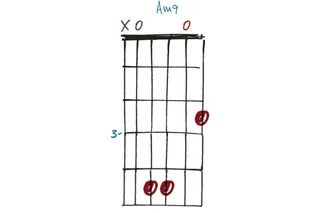 Example 1. A minor 9
Example 1. A minor 9
This A minor 9 chord beautifully incorporates the open B string, creating a shimmering 9th interval. The close semitone relationship between the open second string (B) and the fretted C on the third string adds a subtle, pleasing dissonance. While shapes like this are often position-specific due to the open strings, experimenting with moving them can sometimes yield surprising and interesting results. Try shifting this shape and see what new textures you can uncover.
Amaj9
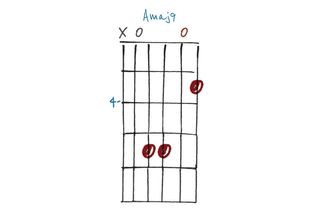 Example 2. Amaj9
Example 2. Amaj9
By moving the Am9 shape up just one fret, we arrive at this lush A major 9 chord. The ‘major’ quality comes from the major 7th (G#), which is present on both the fourth and first strings. The open second string still provides the 9th (B), maintaining its interval relationship to the other notes in the chord. This simple shift from minor to major highlights how small changes in fingering can dramatically alter the mood and color of a chord, offering a valuable technique for acoustic guitarists seeking sonic variety.
Bb minor 6
 Example 3. Bb minor 6
Example 3. Bb minor 6
For this Bb minor 6 chord, careful muting of the first and sixth strings is crucial – unless you’re aiming for a particularly dissonant effect! The open third string rings out as the 6th (G), which combines with the fretted notes of the Bb minor triad to give the chord its name. Understanding how chord names are derived from their intervals, as demonstrated here, can greatly simplify the process of learning and remembering new voicings.
Bb6
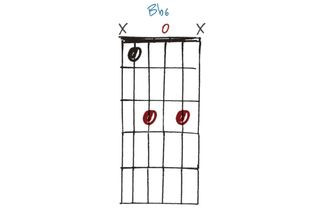 Example 4. Bb6
Example 4. Bb6
Building upon the Bb minor 6, this Bb6 chord is created by raising the minor 3rd (Db) up a half step to D on the second string. The open third string (G) continues to function as the 6th. This creates a movable chord shape, with the open G string acting as a constant ‘drone’ note as you shift the chord up and down the neck. Experimenting with movable shapes like this can reveal new chord progressions and melodic ideas on your acoustic guitar.
Bm11
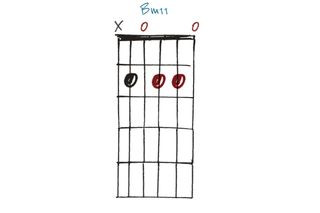 Example 5. Bm11
Example 5. Bm11
This B minor 11 chord is an example of an extended minor chord, but it can also be interpreted as a ‘polychord’ – a chord that combines elements of two or more chords. In this case, it features an A major triad (A-C#-E) on the top three strings over a B root note on the fifth string. The open fourth string provides the minor 3rd (D). This complex voicing demonstrates how acoustic guitar can handle rich, layered harmonies.
Bmaj9
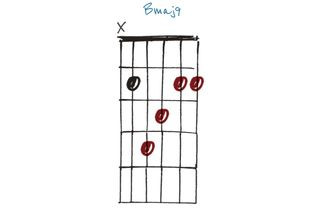 Example 6. Bmaj9
Example 6. Bmaj9
This B major 9 is a barre chord, making it easily movable to any key or position while maintaining its intervallic structure. Continuing the polychord concept from the Bm11 example, you could perceive this chord as an F# major chord (F#-A#-C#) played over a B bass note. In an overdubbing context, understanding chords as polychords can open up interesting arrangement possibilities, especially when layering acoustic guitar parts.
Cmadd9
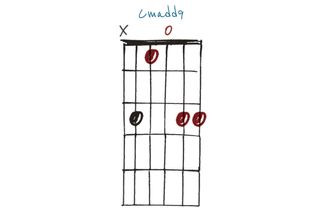 Example 7. Cmadd9
Example 7. Cmadd9
This C minor add 9 chord is a fantastic example of how to add harmonic complexity to your acoustic guitar playing using familiar open-position chord shapes. It’s particularly useful when you’re building a song using strummed open acoustic chords and want to maintain a sense of consistency in voicing, which can sometimes be lost when switching between open and fretted chord positions. While it might require a slight stretch at first, this chord is well worth mastering for its sonic richness.
C add9(add b5)
 Example 8. C add9(add b5)
Example 8. C add9(add b5)
This C add9(add b5) chord proves that a chord doesn’t need to be difficult to play to have a complex and intriguing name! It’s especially well-suited for fingerstyle acoustic guitar playing, where a regular C major chord might sound too conventional. The add9 (D) is found on the second string, while the b5 (Gb) is on the fourth string, creating a unique and sophisticated flavor.
C#m9
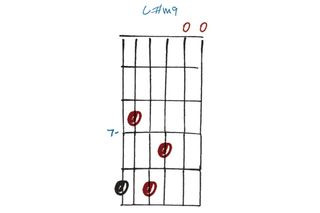 Example 9. C#m9
Example 9. C#m9
This C# minor 9 chord is a blend of fretted and open strings, utilizing all six strings to create a full, resonant sound that’s perfect for strumming on acoustic guitar. This is another chord that’s worth experimenting with in different positions on the fretboard, as it can yield surprisingly beautiful variations. The intervallic relationships will change as you move it, but exploring these changes can be a rewarding exercise in ear training and chord discovery.
C#maj7
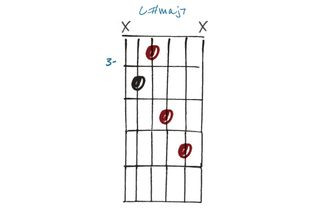 Example 10. C#maj7
Example 10. C#maj7
This C# major 7 chord doesn’t utilize any open strings, but what it lacks in open-string resonance, it gains in movability. You might notice that the 5th (G#) is omitted from this voicing; this is a common technique in jazz chord voicings to create a smoother, less cluttered sound. In contrast, a C# major 7 chord that includes the 5th might sound more typical in rock and pop contexts.
Dm6/9
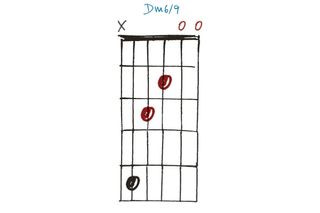 Example 11. Dm6/9
Example 11. Dm6/9
By playing a D minor triad (D-F-A) on the fifth, fourth, and third strings and combining it with the open second string (B) and first string (E), we create a D minor 6/9 chord. Technically, this is a D minor 6 (add9), but chord charts often abbreviate it to D minor 6/9. This voicing is an excellent example of how to create complex and interesting chords while still leveraging the natural resonance of open strings on acoustic guitar.
D6/9
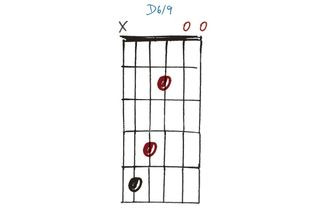 Example 12. D6/9
Example 12. D6/9
Similar to the Dm6/9, this D6/9 chord is formed by changing the minor 3rd (F) to a major 3rd (F#) on the fourth string, resulting in a brighter and more uplifting sound. The naming convention remains the same: D6 (add9) shortened to D6/9. While it might be a bit of a stretch to finger initially, this chord is fantastic for maintaining that signature ‘open-string sound’ that is so characteristic of acoustic guitar music, especially when used in combination with other open-voiced chords.
Ebm11
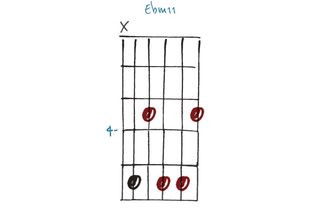 Example 13. Ebm11
Example 13. Ebm11
This Eb minor 11 chord has its root on the fifth string, and ascending through the chord, we find the minor 3rd (Gb), b7 (Db), and 9th (F) in order. The distinguishing factor between this and an Eb minor 9 chord is the addition of the 11th (Ab) on the first string. Notice also the complete Db major triad (Db-F-Ab) embedded within this voicing, highlighting the rich harmonic possibilities within extended chords.
Ebmaj7
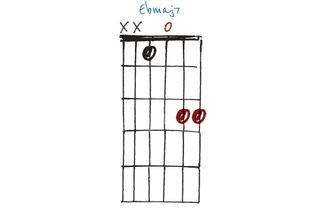 Example 14. Ebmaj7
Example 14. Ebmaj7
This voicing of Eb major 7 is somewhat sparse in the bass frequencies but is particularly useful for maintaining consistency with other open-voiced chords in a song. In a band setting, for fingerstyle playing, or when combined with another guitar using more traditional voicings, the lack of strong bass notes in this chord becomes less significant. It’s a great example of a chord voicing optimized for specific musical contexts.
Emadd9
The E minor add 9 is a frequently used chord on acoustic guitar, yet it consistently sounds fresh and inspiring, avoiding any sense of being overused. It’s particularly well-suited to the acoustic guitar’s natural resonance. Experiment with moving this shape around the fretboard to discover other pleasing variations, both for strumming and fingerpicking styles.
Eadd9
The major counterpart to the Emadd9, this E add 9 chord features the major 3rd (G#) on the third string, giving it a brighter, more uplifting character. Like the Emadd9, this chord can also be moved around the fretboard, although perhaps to a slightly lesser extent due to its voicing. Exploring these variations will reveal some very pleasant and sometimes surprising alternatives to standard E major chords.
Fm9
While not an open chord, this Fm9 chord uses all six strings to create a ‘wide’ and expansive sound on acoustic guitar. It manages to retain enough ‘jangle’ and openness to blend seamlessly with more open-voiced chords in a musical arrangement. Removing the G note (the 9th) from the first string transforms this chord into an alternative Fm7 voicing, offering a slightly less extended option.
Fsus2/A
If you find the full F barre chord challenging or simply prefer alternatives, this Fsus2/A chord is an excellent option. It may not be suitable in every musical situation, particularly if you need a strong F bass note. However, if you can do without the low F, this voicing becomes more versatile and can be moved around the neck to create interesting suspended chord variations.
F#m11
If your fretting-hand thumb is flexible enough, you can add the root note to this F# minor 11 chord by fretting the 2nd fret of the sixth string with your thumb. Even without the thumb-fretted root, it still sounds rich and full and will create a wonderful texture when played alongside a band mix or layered with a regular F#m chord played on another guitar.
F#7add4
Famously associated with Alex Lifeson of Rush, this F#7 add4 chord is a fantastic ringing acoustic chord. As Alex himself would likely attest, this voicing is highly movable around the fretboard and can be used to great effect, offering an intriguing alternative to more common barre chord shapes and providing a unique sonic signature.
Gm11
Some chords require careful muting for clean strumming, and this G minor 11 is one such example. It provides a beautiful alternative or overdub option to a standard G minor or G minor 7 chord. Experimenting with moving this shape up or down the neck by a fret or two can yield interesting sonic variations to suit your musical taste and context.
Gmaj7
This G major 7 chord doubles up on the major 7th interval (F#), featuring it on both the fourth and first strings. For a less harmonically dense alternative, try letting the fourth string ring open, which will evoke a more ‘Eagles’-like vibe. Similar to the Gm11, the fifth string is muted in this voicing to achieve clarity and prevent muddiness.
G#m9
Keeping the fifth string muted, this G# minor 9 chord offers a resonant, open-voiced alternative to what would otherwise be a challenging barre chord shape in this key. By moving this voicing to different positions on the neck, you can evoke the styles of guitarists like Steve Howe or even Joni Mitchell, known for their sophisticated chord voicings and open tunings.
G#maj7
This jazzy G# major 7 chord is a bit of an unconventional voicing, featuring a muted fifth string and a slanted barre to catch the F# (major 7th) on the first string. However, it’s worth the effort to learn as this movable version of the major 7th chord provides a valuable alternative for adding harmonic variety to your acoustic guitar playing and expanding your chord vocabulary.
C#7 (#5#9)
The first of our ‘bonus chords’, this C#7 (#5#9) is a prime example of a chord that is easy to play despite its intimidating name. It functions beautifully as a dominant chord resolving to F# minor 11 (as seen in Example 19). The #5 (A) is found on the third string, and the #9 (E) is the open first string, creating a colorful and harmonically rich dominant sound.
Aadd9/E
This A add9/E chord sounds as if it might be in an open or altered tuning, but it’s surprisingly easy to play in standard tuning and utilizes a convenient open position. Try combining it with the C#7 (#5#9) and F# minor 11 chords from Examples 25 and 19 to create a chord progression that maintains that beloved strummed acoustic sound but with a unique and sophisticated twist.
Em9
This voicing of E minor 9 is often used alongside or in place of the Emadd9 (Example 15). However, be aware that adding the b7 (D) on the second string does limit the movability of this particular chord shape. Nevertheless, experimenting with moving it slightly can still yield interesting and unexpected sonic textures on your acoustic guitar.
Em11
E minor is undeniably one of the most versatile and beautiful chords on acoustic guitar, so we make no apologies for including yet another variation! This Em11 chord features a barre at the second fret, giving us the 11th (A) on the third string and the 9th (F#) on the first string. By omitting the open sixth string, you gain the ability to move this voicing to any key across the fretboard, making it a highly adaptable and useful chord shape.
F#m11(b9)
This dramatic F# minor 11 (b9) chord has a versatile and evocative sound, capable of conveying moods ranging from a ‘bad guy walking into a bar’ to the introspective sounds of Jeff Buckley and beyond. Essentially, it combines a power chord on the lowest three strings with the remaining strings ringing open and jangly, making it particularly effective for strummed rhythms and adding a cinematic quality to your acoustic playing.
Em/maj9
We conclude with what could be considered the ultimate ‘ending’ chord. This E minor/major 9 is not a chord you’ll hear every day in acoustic music, but perhaps that should change, starting today! Its unique blend of minor and major qualities creates a sense of resolution and harmonic richness, making it a compelling choice for ending songs or sections and adding a touch of unexpected beauty to your acoustic guitar arrangements.

